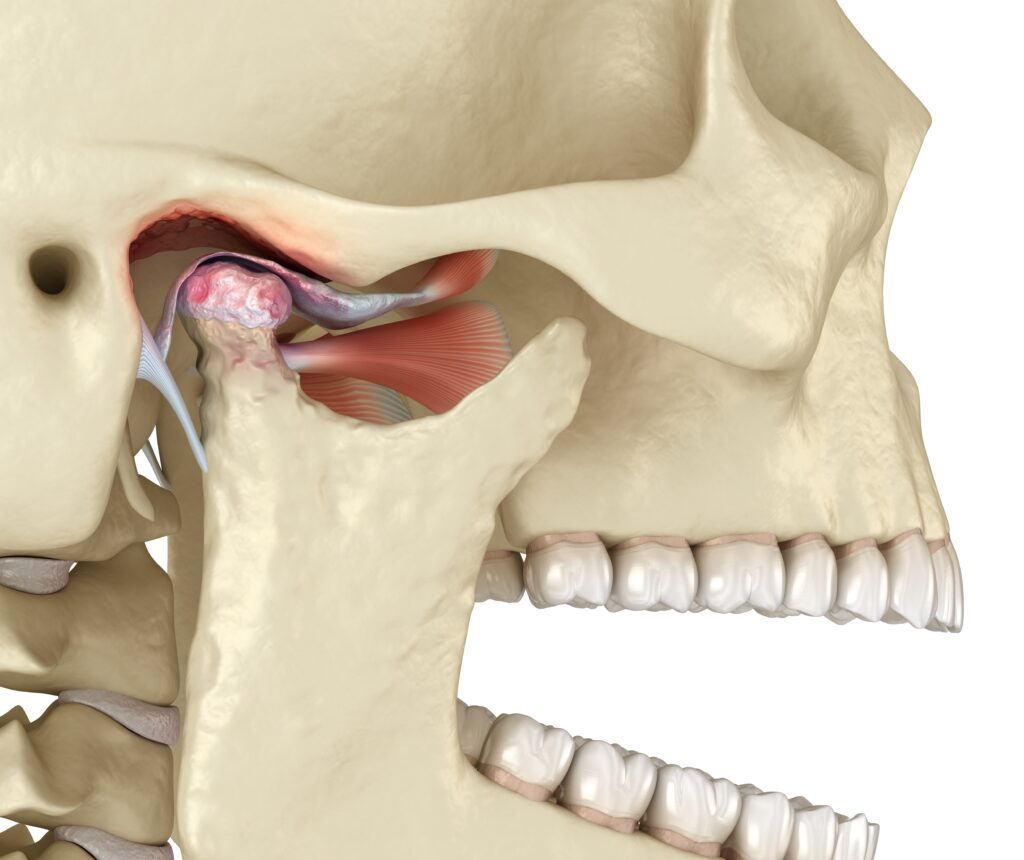In today’s fast-paced world, many health issues fly under the radar, often until they significantly disrupt our daily lives. One such condition is TMJ Disorders, a growing yet somewhat silent epidemic affecting countless individuals. TMJ Disorders, or Temporomandibular Joint Disorders, involve pain and dysfunction in the jaw joint and muscles controlling jaw movement. The implications can be vast, ranging from mild discomfort to severe pain and limited jaw movement, making daily tasks challenging.
At Smile Science Dental Spa in Glendale, AZ, we’re no strangers to TMJ Disorders. Under the expert guidance of Dr. Richard Dawson and Dr. John Turke, our practice has successfully helped numerous patients understand, manage, and even overcome the hurdles associated with this condition.
Understanding TMJ: What is it?

The Temporomandibular Joint (TMJ) might not be a term many are familiar with, but it’s a critical component of our anatomy. It’s the hinge joint that connects your jaw to the temporal bones of your skull, which are situated right in front of each ear. This joint facilitates the up-and-down and side-to-side movements of your jaw.
Imagine a day without being able to talk, chew, yawn, or even express through facial gestures; it’s almost unthinkable. This underscores the significance of the TMJ – it plays a pivotal role in many of our daily activities. Just like any other joint in our body, the TMJ is prone to disorders, and when affected, it can take a toll on the quality of our lives. It’s not just about the ability to chew your favorite food or share a laugh; it’s about maintaining a fundamental aspect of human connection and expression.
Common Symptoms of TMJ Disorders

TMJ Disorders manifest in various ways, and while experiences might differ from one individual to another, there are common symptoms that many patients report. At the forefront is the unmistakable pain in the jaw area. This discomfort can be a constant nagging sensation or sudden sharp pains, often exacerbated when speaking or eating.
Another telltale sign is the presence of clicking or popping sounds when opening or closing the mouth. Not everyone who experiences these sounds has a TMJ Disorder, but in combination with other symptoms, it can be indicative. Furthermore, some patients describe a grinding sensation, which can be both felt and heard.
One of the most concerning symptoms is difficulty in opening or closing the mouth. For some, this could mean a limited range in motion, while others might experience “lockjaw”, where the jaw becomes temporarily stuck in a position, either open or closed.
Causes Behind TMJ Disorders

Understanding the root causes of TMJ Disorders is crucial for effective treatment. One primary cause is physical injury or trauma to the jaw or the joint itself. A blow or impact, for instance from sports or accidents, can lead to misalignment or damage to the joint components.
Arthritis is another culprit. Just as it affects other joints in the body, types of arthritis, especially osteoarthritis and rheumatoid arthritis, can impact the TMJ, causing inflammation, pain, and degradation.
Teeth grinding, or bruxism, is also a significant factor behind many TMJ Disorder cases. Often an unconscious act during sleep, bruxism exerts excessive pressure on the joint, leading to wear and tear over time. Beyond the physical act of grinding, the stress and anxiety that often trigger bruxism can themselves cause muscle tension and pain in the jaw area.
At Smile Science Dental Spa in Glendale, AZ, Dr. Richard Dawson and Dr. John Turke have encountered and treated these causes and more, providing relief and solutions to patients grappling with the complexities of TMJ Disorders.
Diagnosis: How Dr. Richard Dawson and Dr. John Turke Can Help
TMJ Disorders can be perplexing. Sometimes, what might seem like a minor jaw pain can turn into a full-blown TMJ Disorder, and sometimes, it’s just a passing pain. This is where the role of trusted professionals becomes paramount. At Smile Science Dental Spa in Glendale, AZ, Dr. Richard Dawson and Dr. John Turke, while not specialized TMJ experts, bring to the table a broad dental knowledge that aids in diagnosing TMJ issues.
Early diagnosis can significantly influence the outcome for TMJ Disorder patients. Recognizing the signs and seeking professional advice at the onset can prevent potential complications, reducing the severity of symptoms and paving the way for more straightforward treatment options. Dr. Dawson and Dr. Turke’s general understanding of TMJ Disorders equips them to detect early signs, provide guidance, and, if needed, refer patients to specialized professionals for advanced care.
Treatment Options Available in Glendale, AZ

The path to TMJ Disorder treatment isn’t a one-size-fits-all approach. It’s tailored to the individual, their symptoms, and the underlying cause. Non-surgical interventions are often the first line of defense. These may include:
- Physical therapy exercises to strengthen jaw muscles.
- Bite guards or splints, especially beneficial for those who grind their teeth.
- Medications to reduce inflammation and relieve pain.
However, in more severe cases or when non-invasive treatments don’t yield results, surgery might be considered. It’s usually viewed as a last resort and pursued when the joint itself is damaged or when there’s a need to correct a specific issue causing the disorder.
While Smile Science Dental Spa mainly focuses on general dentistry, Dr. Dawson and Dr. Turke’s commitment to their patient’s well-being is unwavering. They offer guidance, initial treatment options, and, when necessary, collaborate with or refer to TMJ specialists within the Glendale, AZ community. The aim is always to ensure that patients get the best, most comprehensive care for their TMJ concerns.
Prevention Tips

While the treatment of TMJ Disorders can provide relief, preventing or minimizing the onset of symptoms is often more effective and less strenuous. Here are some habits to inculcate and strategies to reduce strain on the TMJ:
- Mindful Eating: Opt for softer foods that don’t require extensive chewing, and avoid sticky candies or gum. This reduces stress on the jaw joint.
- Avoid Wide Jaw Movements: Activities like wide yawning, loud singing, or biting into large foods like apples can strain the TMJ. It’s best to be conscious and avoid excessive stretching.
- Teeth Position: Try to keep teeth slightly apart when not eating or speaking to prevent them from grinding and to relieve pressure on the jaw.
- Jaw Exercises: Regular gentle exercises can strengthen jaw muscles and enhance flexibility. However, it’s essential to consult with a dentist before starting any regimen.
- Stress Management: Since stress can lead to teeth grinding and clenching, practices like meditation, deep breathing, or even counseling can be beneficial.
- Regular Dental Checkups: Routine visits to dentists like Dr. Dawson and Dr. Turke at Smile Science Dental Spa can help in early detection of potential issues, including signs of bruxism or bite misalignment.
Conclusion: Taking the Next Step
TMJ Disorders, while often overlooked, can significantly impact one’s quality of life. It’s essential not just to treat but to prevent, and the first step in that journey is seeking professional care. With the combined experience and dedication of Dr. Dawson and Dr. Turke, residents of Glendale are in capable hands.
While they offer initial guidance and treatment options, their commitment extends beyond their dental spa’s walls. They believe in holistic care, guiding patients towards specialized professionals if needed, ensuring that everyone receives comprehensive care for their TMJ concerns.
At Smile Science Dental Spa, it’s more than just dentistry; it’s about providing a foundation for a healthier, pain-free future. So, if you or a loved one experience symptoms or simply want to learn more about TMJ Disorders, take the step and schedule an appointment. Your jaw will thank you!
Further Reading
- Temporomandibular Syndrome
- Temporomandibular Disorders: Current Concepts and Controversies in Diagnosis and Management
- Temporomandibular Joint Disorders: A Review of Etiology, Clinical Management, and Tissue Engineering Strategies
- Management of pain in patients with temporomandibular disorder (TMD): challenges and solutions
- Temporomandibular disorders: a review of current concepts in aetiology, diagnosis and management






